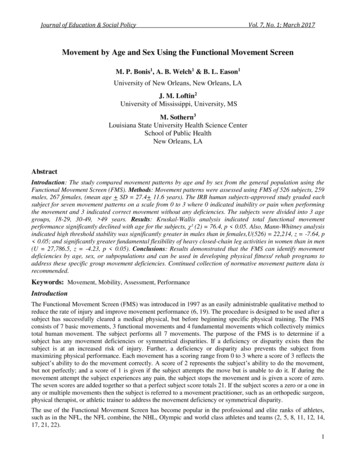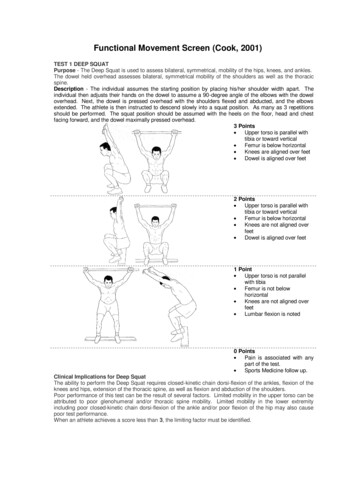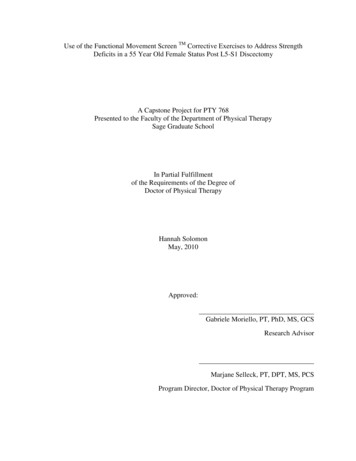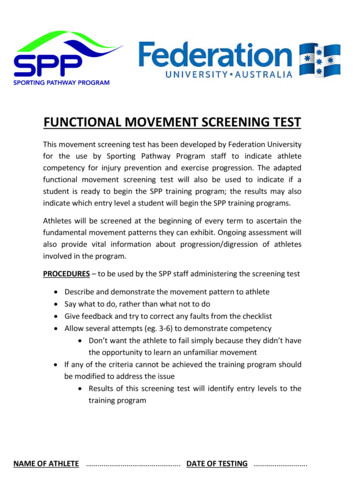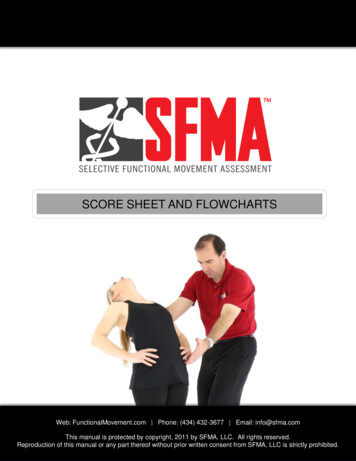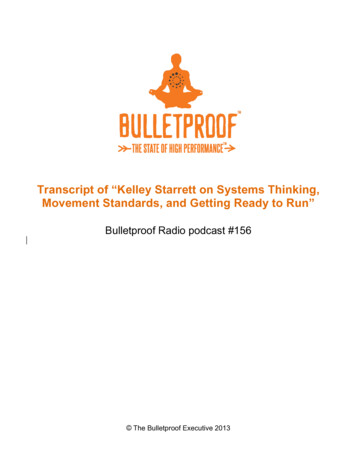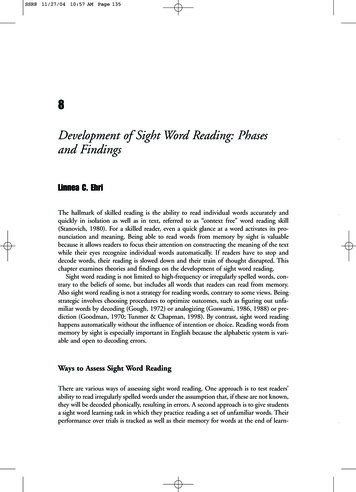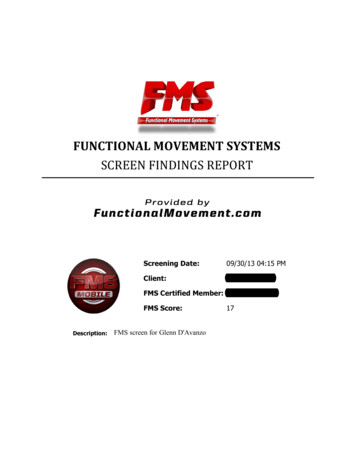
Transcription
FUNCTIONAL MOVEMENT SYSTEMSSCREEN FINDINGS REPORTScreening Date:09/30/13 04:15 PMClient:Glenn D'AvanzoFMS Certified Member: Elizabeth CarusoFMS Score:Description:FMS screen for Glenn D'Avanzo17
FUNCTIONAL MOVEMENT SCREEN SCORE SHEETFMS Certified Member:Elizabeth CarusoClient:Glenn D'AvanzoTESTScreen Date:09/30/13 4:15 PMRAW SCOREDEEP SQUAT2HURDLE STEPINLINE LUNGESHOULDER MOBILITYIMPINGEMENTCLEARING TESTACTIVE STRAIGHT-LEG RAISEL2R2L3R3L2R1L /R /-Previous Score:N/ACOMMENTS2231-L3R3TRUNK STABILITY PUSHUPPRESS-UP CLEARING TEST-FINALSCORECurrent Score:173 /--L3R3 /--33ROTARY STABILITYPOSTERIOR ROCKINGCLEARING TESTTOTAL317Raw Score: This score is used to denote right and left side scoring. The right and left sides are scored in five of the seven testsand both are documented in this space.Final Score: This score is used to denote the overall score for the individual tests. The lowest raw score is carried over to give afinal score for the test. A person who scores a three on the right and a two on the left would receive a final score of two. Thefinal score is then summarized and used in the total score.Clearing Test: A positive indicates pain. A negative indicates no pain. If pain is present ( ), the score for that test would resultin a 0.FunctionalMovement.com2/10Monday, September 30, 2013
UNDERSTANDING THE REPORTThe 7 FMS movement pattern tests are listed in order of priority from the most basic andfundamental to the most complex and functional - the general order of importance in theFunctional Movement Screen .Each movement pattern score contains a corresponding symbol that provides a recommendedfocus when evaluating or developing exercise programs.These symbols are described below:Symbol:FunctionalMovement.comSymbol Meaning:AssociatedScores:RecommendedConditioning Focus:Movement PatternProgrammingUnrestrictedIndicated by Optimal(3,3) and Acceptable(2,2) Scores OnlyPursue Volume andIntensity While MaintainingProper TechniqueMovement PatternProgramming CautionedIndiciated by ScoresContaining (2,3)AsymmetricalCombination OnlyEmphasize Technique OverVolume and Intensity toImprove AsymmetryMovement PatternProgrammingRestrictedMovement PatternDysfunction Indicated byAny Score CombinationContaining 1sFocus on CorrectiveExercise to ImproveMovement PatternPain Indicated withMovement PatternAny Score of 0See a Medical Professionalfor Evaluation3/10Monday, September 30, 2013
Movement Pattern ProgrammingUnrestrictedActive Straight Leg Raise (3L, 3R)Findings:Your score represents an Active Straight-Leg Raise test that appears to be optimal on the left and right sides.Objective:Competency in this test should be maintained while focusing on improving other movement tests that are less than optimal.Summary of Results for this Pattern:This score indicates optimal movement quality and shows that mobility and motor control are not compromised in this pattern.Movement quality is not considered a limiting factor when conditioning this pattern.Programming Implications:··Corrective Exercises: Prescribed to maintain available mobility and motor control.Conditioning Exercises: Activities utilizing this pattern (hip hinging, lunging, split squats, running, lower bodyreciprocal patterning) should be performed with the focus placed on technique while improving volume and intensity.FunctionalMovement.com4/10Monday, September 30, 2013
Movement Pattern ProgrammingRestrictedShoulder Mobility (2L, 1R)Impingement Clearing Test (-L, -R)Findings:Your score represents a Shoulder Mobility test that appears dysfunctional on one side and acceptable on the other. Thedifference between the left and right sides represents asignificant asymmetry.Objective:The Shoulder Mobility test is considered acceptable with symmetrical 2s or optimal with symmetrical 3s.Summary of Results for this Pattern:(Note that the score of 1 is priority and score of 2 is not a concern until the score of 1 improves. All recommendations will focuson improving the score of 1.)Mobility (in the pattern that displays a score of 1):··Limited in shoulder flexion/abduction/external rotation and/or shoulder extension/adduction/internal rotation duringupper body reciprocal patterning.Limited in thoracic spine and/or shoulder complex during upper body reciprocal patterning.Motor Control (in the pattern that displays a score of 1):··Inefficient motor control of thoracic spine and shoulder complex during upper body reciprocal patterning.Compensatory motions of the thoracic spine and shoulder complex may exist due to asymmetry.Programming Implications:··Corrective Exercises: Highly recommended to improve Shoulder Mobility movement pattern quality.Conditioning Exercises: Avoid activities that will load or stress this pattern (overhead pressing, rowing, reciprocalshoulder motions, upper body reciprocal patterning) until acceptable symmetry is achieved.FunctionalMovement.com5/10Monday, September 30, 2013
Movement Pattern ProgrammingUnrestrictedRotary Stability (3L, 3R)Posterior Rocking Clearing Test (-)Findings:Your score represents a Rotary Stability test that appears optimal on the left and right sides.Objective:Competency in this test should be maintained while focusing on improving other movement tests that are not consideredoptimal.Summary of Results for this Pattern:This score indicates optimal movement quality and shows that mobility and motor control are not compromised in this pattern.Movement quality is not considered a limiting factor when conditioning this pattern.Programming Implications:··Corrective Exercises: Prescribed to maintain the available mobility and motor control.Conditioning Exercises:Activities utilizing this pattern (climbing, crawling, reciprocal patterning) should beperformed with the focus placed on technique while improving volume and intensity.FunctionalMovement.com6/10Monday, September 30, 2013
Movement Pattern ProgrammingUnrestrictedTrunk Stability Push-Up (3)Press Up Clearing Test (-)Findings:Your score represents a Trunk Stability Push-Up pattern test that appears to be optimal.Objectives:Competency in this test should be maintained while focusing on improving other movement tests that are not consideredoptimal.Summary of Results for this Pattern:This score indicates optimal movement quality and shows that mobility and motor control are not compromised in this pattern.Movement quality is not considered a limiting factor when conditioning this pattern.Programming Implications:··Corrective Exercises:Prescribed to maintain the available mobility and motor control.Conditioning Exercises: Activities utilizing this pattern (symmetrical pressing, pulling and overhead activities) shouldbe performed with the focus placed on technique while improving volume and intensity.FunctionalMovement.com7/10Monday, September 30, 2013
Movement Pattern ProgrammingUnrestrictedIn-Line Lunge (3L, 3R)Findings:Your score represents an Inline Lunge test that appears to be optimal on the left and right sides.Objectives:Competency in this test should be maintained while focusing on improving other movement tests throughout the screen.Summary of Results for this Pattern:This score indicates optimal movement quality and shows that mobility and motor control are not compromised in this pattern.Movement quality is not considered a limiting factor when conditioning this pattern.Programming Implications:··Corrective Exercises: Prescribed to maintain the available mobility and motor control.Conditioning Exercises:Activities utilizing this pattern (hip hinging, lunging, split squats, running, etc.) should beperformed with the focus placed on technique while improving volume and intensity.FunctionalMovement.com8/10Monday, September 30, 2013
Movement Pattern ProgrammingUnrestrictedHurdle Step (2L, 2R)Findings:Your score represents a Hurdle Step test that appears to be acceptable on the left and right sides.Objective:The Hurdle Step test is considered optimal with symmetrical 3s.Summary of Results of this Pattern:This score indicates a minimal acceptable level of mobility and motor control in the Hurdle Step. Maintenance of this score isimportant and re-testing at a lower score or asymmetry is cause for concern. Improvement in this test increases availablemobility and motor control (buffer zone) reducing the need for compensation while optimizing the benefit of conditioningexercises using this pattern.Summary of Results of this Pattern:Mobility:··Limitations in mobility will more than likely be identified in the Shoulder Mobility and Active Straight-Leg Raise tests. Ifthe results of these tests are dysfunctional they will take priority.Minor limitations in mobility of one or more of these areas:oooThoracic spine and shoulder complexHip flexion and ankle mobility of stepping legHip extension and ankle mobility of standing legMotor Control:·Minor inefficiencies in static motor control during single-leg stance patterning in one or all of the following:ooo·Upper Back and ShoulderFeetMinor inefficiencies in dynamic motor control during single-leg stance patterning in one or all of the following:oo·Trunk and PelvisThe hip, knee and ankle of the stepping legThe hip, knee and ankle of the standing legCompensatory Motions of the trunk, pelvis, hips, knees, ankles and shoulder may exist.Programming Implications:··Corrective Exercises: Prescribed to maintain and potentially increase the available mobility and motor control whenperforming higher-level activities.Conditioning Exercises: Activities utilizing this pattern (single-leg stance, impact activities, reciprocal patterning)performed with a primary focus of technique over volume and intensity.FunctionalMovement.com9/10Monday, September 30, 2013
Movement Pattern ProgrammingUnrestrictedDeep Squat (2)Findings:Your score represents a Deep Squat that appears to be acceptable.Objectives:The Deep Squat test is considered optimal with a score of 3.Summary of Results of this Pattern:This score indicates a minimal acceptable level of mobility and motor control in the Deep Squat. Maintenance of this score isimportant and re-testing at a lower score or asymmetry is cause for concern. Improvement in this test increases availablemobility and motor control (buffer zone) reducing the need for compensation while optimizing the benefit of conditioningexercises using this pattern.Mobility:··Significant limitations in mobility will more than likely be identified in the Shoulder Mobility and Active Straight LegRaise tests. If the results of these tests are dysfunctional they will take priority.Minor limitations in mobility of one or more of these areas:ooooThoracic spine and shoulder complexHipKneeAnkleMotor Control:·Minor inefficiencies in static motor control during symmetrical patterning in one or all of the following:ooo·Upper Back and ShoulderFeetMinor Inefficiencies in dynamic motor control during symmetrical patterning in one or all of the following:ooo·Trunk and PelvisHipKneeAnkleCompensatory Motions of the trunk, pelvis, hips, knees, ankles and shoulders may exist.Programming Implications:··Corrective Exercises: Prescribed to maintain and potentially increase the available mobility and motor control whenperforming higher-level activities.Conditioning Exercises: Activities utilizing this pattern (pressing, pulling, power with symmetrical base) should beperformed with a primary focus of technique over volume and intensity.FunctionalMovement.com10/10Monday, September 30, 2013
Functional Movement Screen . Each movement pattern score contains a corresponding symbol that provides a recommended focus when evaluating or developing exercise programs. These symbols are described below: FunctionalMovement.com 3/10 Monday, September 30, 2013. Active Straight Leg Raise (3L, 3R) Findings: Your score represents an Active Straight-Leg Raise test that appears to be optimal
